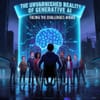Generative AI has taken the tech world by storm, dazzling us with its ability to create everything from art to text. While the potential of these systems is undeniable, it’s essential to take a step back and examine some of the hard truths that accompany this exciting technology.
At its core, generative AI operates by learning from vast datasets, enabling it to produce content that often resembles human creativity. However, this capability isn’t without its pitfalls. One of the primary concerns is the quality and accuracy of the generated content. While these systems can create impressive outputs, they are not infallible. Errors and inconsistencies can creep in, leading to misinformation or subpar results that can mislead users.
Moreover, the ethical implications of generative AI are significant. Questions arise about authorship and ownership: if an AI creates a piece of art or writing, who owns it? This ambiguity poses challenges for creators and raises important legal and moral considerations.
Another reality check comes from the limitations of these technologies. Despite their sophistication, generative AI lacks true understanding and context. It can mimic styles and generate text, but it doesn’t possess the depth of human experience or emotion. This limitation can lead to outputs that, while technically sound, may feel hollow or disconnected.
As we navigate this brave new world of generative AI, it’s crucial to maintain a balanced perspective. Embracing the potential of these technologies is important, but so is recognizing their shortcomings. Developers and users alike must approach generative AI with a critical mindset, ensuring that they are aware of its limitations and ethical implications.


